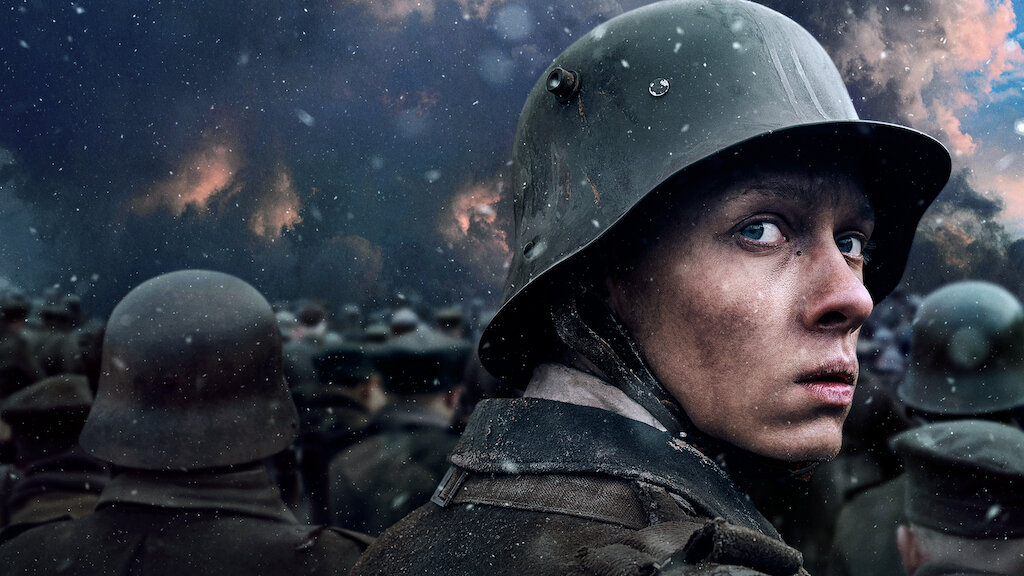
The new German remake of All Quiet on the Western Front spends its first 12 minutes in a montage without dialogue that provides a pretty concise view of how the German war machine of WWI continually substituted fresh new bodies to fill the recycled uniforms taken off newly dead corpses, as machine guns and trench warfare destroyed a generation of young men.
A pack of wolves are startled by an explosion. An overhead shot of dead soldiers on the semi-frozen hellscape. The camera then tracks into the German trenches, where the men are ordered to go “over the top,” where most will be killed, some immediately, others as they attempt to cross no man’s land.
After the title card, a single dead soldier is tossed off the scrap heap of equally dead men. His uniform is removed, and then placed into a giant duffle bag containing many more like it, transported back to Berlin, where we see a man wheeling multiple duffle bags full of uniforms past a wall of boxes of clothes that is vaguely reminiscent of the warehouse scene at the end of Raiders of the Lost Ark. A squad of women wash the blood out of the outfits in giant vats, and sew up the bullet holes.
A pounding, ominous three note leitmotif played on a heavily distorted harmonium repeats, seemingly in a loop. (And will repeat at various times throughout the movie, whenever the Fatherland’s war machine is about to churn into action.)
A man is seen in the back of a truck, transporting the uniforms to their next destination, as the titles read “NORTHERN GERMANY, SPRING 1917. THIRD YEAR OF WAR.”
We cut to an innocent looking young man (Felix Kammerer in his debut film performance, playing lead character Paul Bäumer), frantically riding his bike into town to school. Paul and his classmates are all very excited about enlisting, even if it means faking their parents’ signatures.
They’re whipped into a patriotic frenzy by their martinet professor. They report for basic training, and receive their uniforms. Paul notices that there’s already another soldier’s name attached to his jacket’s coat loop. The officer issuing uniforms tells him that the clothes “didn’t fit him. Happens all the time.” He then rips the tag off and tosses it onto the floor, into a pile of similar tags.
And by then we’re into the film proper; an unflinching look at the horrors of the First World War.
Hollywood Discovers the Great War
In 2009 the late Terry Teachout wrote an article for the Wall Street Journal on why there have been so many WWII Movies: “The War That Never Ends. What World War II movies tell us about America’s only cultural consensus:”
How do you make big-budget movies in a country where fewer cultural values are shared and common-denominator opinions are growing less common? Might it be that the film industry as we know it is doomed to decline so long as America remains a 50/50 nation? I’m not sure I’d go that far—not quite, anyway. But the success of “Inglourious Basterds” suggests that most Americans, no matter how they feel about waterboarding, gay marriage or health-care reform, pine in their secret hearts for a lost world in which everyone can agree on at least one thing: Nazis are no damn good.
Indeed. But something’s changed in recent years, as Hollywood and London turned their attention to the War to End All Wars, the Great War. The spate of WWI movies over the last five years includes 2017’s Wonder Woman movie, 2018’s They Shall Not Grow Old, 2019’s 1917, and now the German remake of the 1930 film, All Quiet on the Western Front, which played briefly in theaters before hitting Netflix, which sponsored its production. World War I’s recent newfound popularity is despite the somewhat limited scope it offers most WWI films: Unlike the many varied settings of WWII, with the exception of David Lean’s loosely-WWI-themed trilogy in the 1960s, WWI films are largely tied-down to the themes of static trench warfare and death.
2022’s All Quiet on the Western Front is the second remake of the epochal 1930 film based on the best-selling 1929 novel by Erich Maria Remarque, directed by Lewis Milestone and starring Lew Ayres. But it’s the first version of the film produced in Germany, as German filmmakers continue to grapple with how the unfortunate unpleasantness of 1933-1945 happened. As its director, Edward Berger, told the Onion’s A/V Club late last month:
It’s a German book, it’s been made into an American movie once, or even twice with a television movie. And so why do it again? And so when he asked me, what immediately popped into my head was, “Let’s make a German movie out of this. This is a very German story. The time is right to tell this in the German language.” That just felt undeniable in a way.
I grew up [seeing] many American or British films and some of them war films. And those stories always are very different because it’s a hero’s journey. As an American, you can tell a hero’s journey. You can tell a story that has some pride in the end, that has a sense of something was accomplished and something honorable was done. Because America liberated Europe from fascism, Britain was attacked, had to defend themselves. So that generates a generation of filmmakers that is going to make a very different film. In Germany, it’s nothing to be proud of, that part of history. There’s a sense of shame, guilt, horror, terror, responsibility towards history. And so you feel, in that sense, it’s a weight that you grow up with. I inherited it. It’s in my DNA. And that DNA is going to influence every creative decision and hopefully then make a film that is interesting to share with other countries because it’s a different perspective from the American and British war films. It just felt like I wanted to get that out of my system and share it with other countries and tell that story. And to make a specifically German film.
Certainly, WWI was a massive road marker on the way to the even worse hell of the next war, as Jonah Goldberg wrote in Liberal Fascism:
As countless others have observed, World War I gave birth to all the horrors of the twentieth century. A host of banshees were let loose upon the Western world, shattering old dogmas of religion, democracy, capitalism, monarchy, and mankind’s role in the world. The war fueled widespread hatred, suspicion, and paranoia toward elites and established institutions. For belligerents on both sides, economic planning lent political and intellectual credibility to state-directed war socialism. And, of course, it led to the enthronement of revolutionaries throughout Europe: Lenin in Russia, Mussolini in Italy, and Hitler in Germany.
All Quiet on the Remake Front
Despite its age, Milestone’s 1930 film stands up remarkably well today. (It’s no “hero’s story” as Berger may be implying above.) There’s no doubt that young Stanley Kubrick studied it carefully – at one point, Lew Ayres even flashes what has come to be known as the “crazy Kubrick stare.” (Kubrick’s 1957 breakthrough, Paths of Glory, was no doubt inspired by Milestone’s 1930 film and remains equally watchable.)
In contrast, the 1979 All Quiet, starring Richard Thomas and a far-too-old and far too fat Ernest Borgnine as the food-scrounging, battle-hardened Stanislaus “Kat” Katczinsky leading an otherwise all-British cast, was a brown low-res mess, at least when it aired on CBS, and was released as an early VHS videotape. Seen today, in cleaned up higher-res formats, it hits all of the beats of the 1930 film, and was a solid attempt at retelling Remarque’s story for a-then contemporary American television audience.
The new German All Quiet on the Western Front has its flaws, including some plastic-looking CGI, and lack of character development. There are some remakes of the scenes from the original film, and a similar, if much more drawn out ending. (If you’ve seen either of its predecessor versions, you’ll have a pretty good idea of how this one will end.)
However, there are additional subplots that weren’t in the original film. These include the signing of the armistice with France in Ferdinand Foch’s railroad car in the Forest of Compiègne. It’s understandable that the filmmakers would have wanted to include this scene, given that it sets in motion the next war.
In contrast, there’s also an absolutely clichéd tyrannical bald Prussian general with an enormous mustache who is eager for that one last battle before the ceasefire. But the filmmakers wisely eliminated most of the boot camp scenes to get the young men to the hell of the battlefield much more quickly than its predecessor films, and the sadistic drill instructor who terrorized them, perhaps because of how formulaic those scenes would have appeared after 1987’s Full Metal Jacket.
The penultimate battle in the 2022 film introduces the elements that would come to define 20th century warfare: armored tanks, flamethrowers, and aircraft. The introduction of the tanks is one of the film’s best battle scenes, giving a sense of just how viscerally terrifying their first appearance on the battlefield must have felt to WWI soldiers.
All-in-all, the film is a workman-like effort, but it doesn’t achieve the brilliance of Milestone’s 1930 film, as Variety’s Owen Gleiberman notes in his review:
The 1930 Hollywood version of “All Quiet on the Western Front,” directed by Lewis Milestone, is widely regarded as an anti-war landmark. But, of course, if you watch it now, the war scenes won’t make an audience shudder the way they did a century ago. The bar for terror and carnage onscreen has been raised far beyond that. Edward Berger, the director of the new “All Quiet,” stages his war scenes in what’s become the standard existential bombs-bursting-in-earth, debris-flying-everywhere, war-is-hell-because-its-violence-is-so-random mode of pitiless annihilation. He does it competently, but not better than that; he doesn’t begin to touch the level of imagination that has gripped us in the war cinema of Spielberg, Kubrick, Coppola, Stone, Klimov. Popping out of the trenches, Paul and his fellow soldiers are confronted by a merciless hail of bullets, they’re dunked face down in the mud, they’re shot in the guts or in the head, they’re attacked with bayonets and machetes.
Yet the pale, gentle-hearted Paul, whose newly issued uniform has come off the corpse of a fallen soldier (a point meant to illustrate the endless cycle of death in WWI), somehow fights on and survives. He strikes us as a mild young man, yet there’s a ruthless killer inside him. Whirling to shoot one soldier, then knife another, he becomes, in essence, a desperate action hero, and I put it that way only because I didn’t find his acumen on the battlefield especially convincing. Berger, as a filmmaker, wants to bring us “close” to war, but the horror in “All Quiet on the Western Front” is in your face and also rather tidy in its presentation. Maybe that’s why it feels numbing.
All Quiet’s “making of” video has one last ironic callback to the horrors of 1918: many of the filmmakers are wearing masks, in response to this century’s pandemic.










Join the conversation as a VIP Member